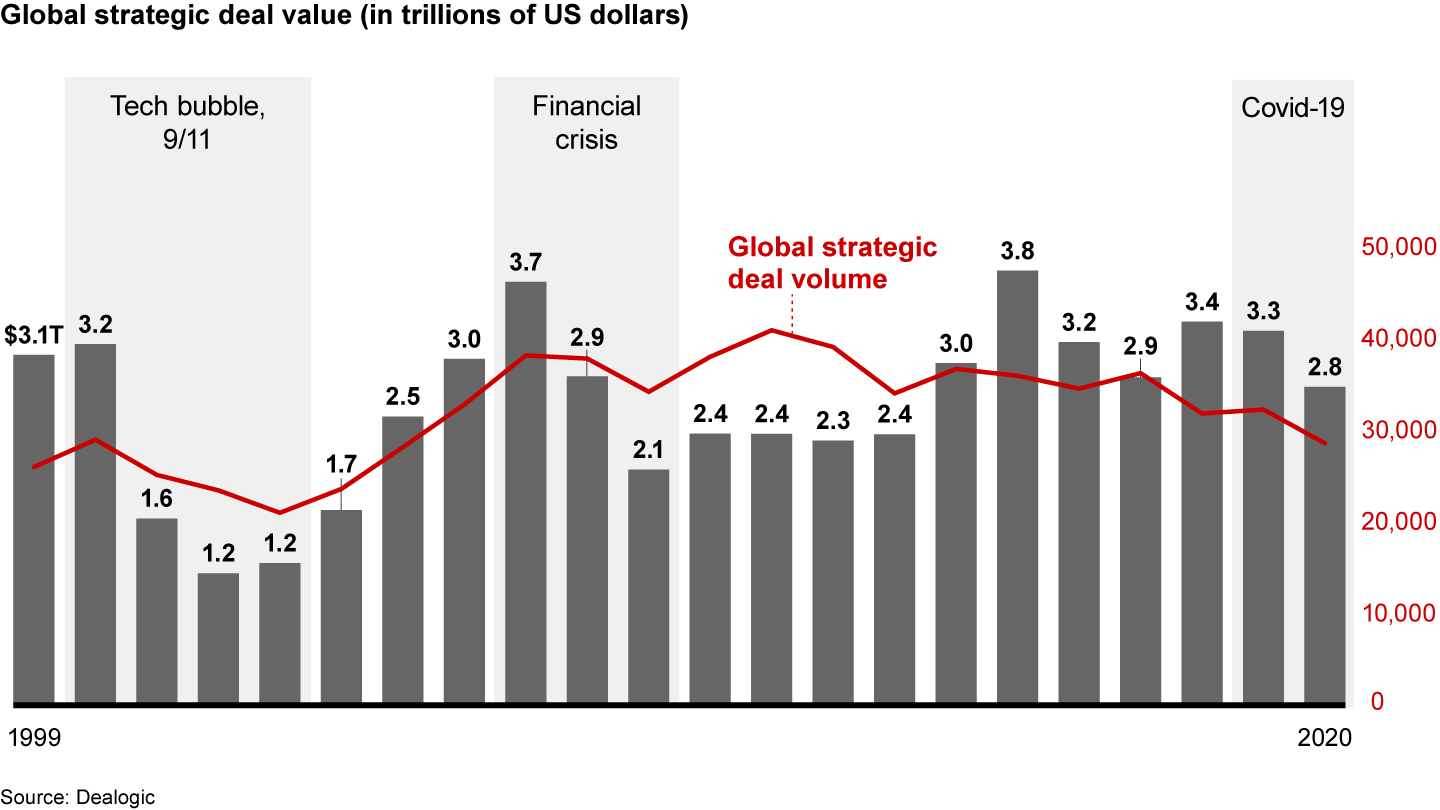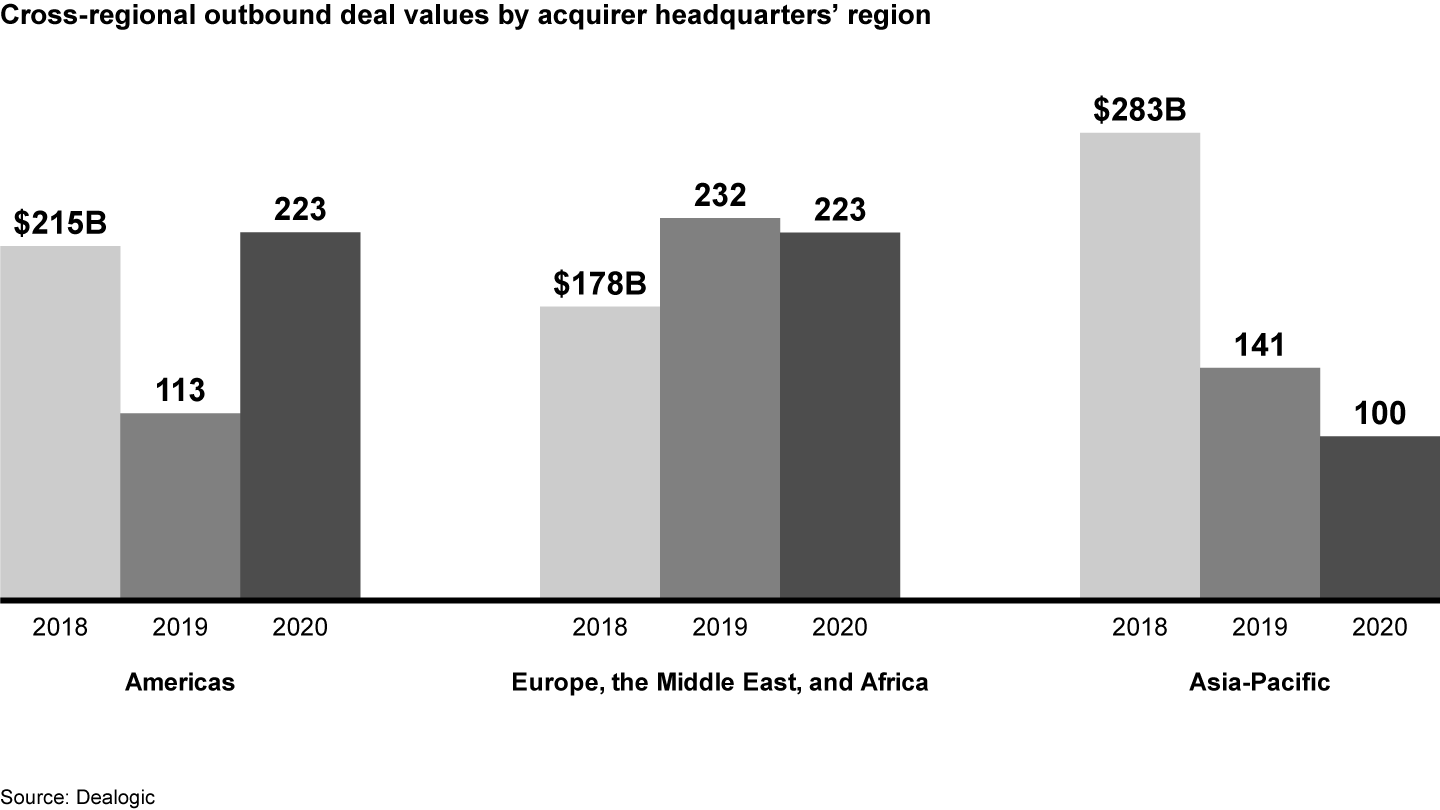M&A Report
 }
}
Executive Summary
- The year 2020 was volatile for M&A, too. We went from an almost complete halt in deal activity in the early months of the crisis to an unexpected rebound in the second half of the year. More than 28,500 deals were announced in 2020.
- Covid-19 accelerated some M&A trends already in place: the urgency to acquire new capabilities for a digital economy, the decline in cross-regional M&A in favor of local or regional deals, and the expanded role of regulators.
- The year 2020 also showed the resilience of M&A professionals, the strength of deal multiples, and the availability of deal financing backed by stimulus actions.
Strong second-half recovery
As the world locked down and masked up, M&A endured.
Similar to every other area of business, deal activity was heavily affected by Covid-19. In the earliest months of the pandemic, M&A virtually ground to a halt. Shareholders and management teams shifted their attention to the priorities of just keeping employees safe and businesses running amid a historic disruption that nobody could have predicted. Companies put deals in progress on the shelf or canceled them outright. Lacking both the bandwidth and a clear view of the future, they paused pursuing new deals.
During the second half of the year, decision makers began to recognize how the world and consumer preferences were changing and the importance of acting fast to buy the newly critical capabilities that would help their businesses adapt to the changing realities and emerge out of the downturn as winners. Deals on the shelf were put back into action as the future direction of each industry came into clearer focus and as governments pumped stimulus funding, keeping deal financing accessible. Deal value rose by more than 30% in both the third and fourth quarters. In the end, more than 28,500 deals were inked by corporate acquirers in 2020, for a total value of $2.8 trillion.
Bain’s Colleen von Eckartsberg, Shikha Dassié, and Andrei Vorobyov discuss key M&A themes from the past year.
Rapid digitalization has underpinned the M&A recovery by enabling M&A processes to be conducted virtually, even as the world was in lockdown. Until last year, digitalization of the M&A process was a discussion topic for the future. Covid-19 accelerated M&A digitalization, however, by many years. Corporate M&A and private equity (PE) teams found themselves quickly adapting to the world of virtual due diligence, deal closing, and integration. They learned just how much could be done with digital tools. While digital collaboration tools and ways of working replaced many of the traditional methods, M&A practitioners also ran into the limitations of technology in the softer aspects of dealmaking, such as relationship building or assessing cultural fit. Roughly 70% of respondents in our November M&A practitioners’ survey said that diligence in 2020 was challenging.
In terms of overall deal volume and value, the recovery was not enough to compensate fully for the lean first half of the year. Full year 2020 delivered meaningful declines both in value (down 15%) and volume (down 11%) vs. the previous year (see Figure 1). By region, the Americas was down 25%, the sharpest regional decline; Asia-Pacific and Europe, the Middle East, and Africa ended the year relatively better, with deal value declines of 4% and 6%, respectively.

The pandemic has also accelerated the importance of environmental, social, and governance (ESG) considerations. In fact, the year 2020 will be remembered as the one in which ESG assumed a prominent place among M&A criteria, requiring the extension of target screening, the development of new diligence capabilities, as well as the use of new sources of data.
Governments play a growing role in M&A
As we wrote in last year's report, regulation has steadily expanded well beyond the traditional mandate of assessing the impact of a deal on market power and consumer benefit. Regulatory powers have moved into concerns such as national interest, data privacy, and the impact on future competition.
In 2020, governments around the world continued to expand their scrutiny of M&A. For example, in May 2020, the German government approved new powers to veto hostile foreign takeover bids for healthcare companies, citing the Covid-19 crisis. The new regulation would apply to non-EU bids for German manufacturers of vaccines, protective equipment, ventilators, medicines, or other supplies. Similarly, the UK government initiated a major upgrade of the takeover law that would allow for extensive scrutiny of cross-border deals in 17 sensitive industries.
The extension of government powers and scrutiny is not limited to healthcare, technology, defense, and other sensitive industries. For example, China Mengniu Dairy was forced to withdraw from its plans to buy Lion Dairy, an Australian beverage business, after getting clear indications that the government would oppose the deal. In the US, the Trump administration mandated that TikTok’s US operations be sold to a US buyer on grounds of national interest, with concerns that user data could be compromised. In France, LVMH attempted to call off its deal with Tiffany when it received a letter from the French foreign ministry requesting LVMH to delay the purchase. The deal is now completed.
As the M&A regulatory landscape continues to evolve, M&A practitioners need to keep up with the latest regulations, both locally and in the addressable markets.
At the same time, however, Europe is lending regulatory support for domestic M&A in some sectors. Recent statements from the European Commission support further domestic consolidation among telecom providers, and the growing regulatory support across regions is encouraging further domestic banking consolidation.
The European regulators also are more open to pan-European deals, which led to announcements such as the Nexi and Nets deal in payments.
As the M&A regulatory landscape continues to evolve, M&A practitioners need to keep up with the latest regulations, both locally and in the addressable markets.
Deals continue to get more local
The rising scrutiny on cross-border deals and ongoing US-China trade tensions have already been slowing down cross-regional trade for a few years now. This trend is decisively accelerated by supply chain concerns exposed by the Covid-19 crisis. Nearly 60% of our survey respondents report that the need to localize supply chains will be a significant factor in evaluating deals going forward.
As an indication of the localization, the number of Asian outbound deals into the Americas and Europe fell by 29% year over year in 2020. With overall deal value down only 2.5%, Greater China acquirers directed 93% of their deal spending toward domestic companies, with only around 5% going to deals in the Americas and Europe, the Middle East, and Africa. This represents a sharp drop from around 11% in 2019 and roughly 25% in 2016, the peak of Chinese outbound M&A.

The Covid-19 travel restrictions have intensified this localization trend. Global cross-regional deal volume declined for the fifth consecutive year, falling by 20% in 2020, mainly out of Asia-Pacific (see Figure 2).
Almost 75% of surveyed M&A practitioners based in Asia-Pacific and Europe, the Middle East, and Africa expect an increased focus on domestic or intra-regional deals. Among US respondents, 44% anticipate concentrating domestically and within the region while 40% expect no significant change from prior years.
The surprising strength in deal valuations across many industries
With the pandemic taking its toll on the economy, it was natural to assume that deal valuations would weaken amid scale consolidation and distressed asset M&A. Indeed, that is what transpired following the global financial crisis, when deal multiples dropped by about 30% over two years.
But in the unpredictable year of 2020, the opposite has happened. Globally, median enterprise value to earnings before interest, taxes, depreciation, and amortization deal multiples increased to 14 times from 13 times in 2019, underpinned by faster-growing industries, where multiples either held steady or increased. In the current low-growth environment, the premium for growth remains high. As a rule, when the cost of capital is low, the value of growth goes up exponentially—and we’re in this superabundant capital market now. So, in industries such as technology, telecommunications, digital media, and pharmaceuticals, which had bright futures that were made even brighter by changes hastened by Covid-19, valuations increased. The opposite was the case in industries such as retail and energy, where valuations weakened.

The State of M&A in 2021
Highlights from our annual M&A report look at how Covid-19 altered the landscape for future deals.
Companies in industries with Covid-19 tailwinds were acquired at exceptional premiums. For example, in telemedicine, Teladoc acquired Livongo for $18.5 billion, implying an expensive sales multiple, with expectations that the strong sales growth would continue into the future. If Covid-19–inspired consumer behavior continues—that is, if consumers maintain their preference for food delivery, telemedicine, online gaming, and the like—those valuations are likely to continue to remain healthy.
Another big factor in strong valuations: the unprecedented government economic stimulus packages. Overall, most developed country governments stepped up their economic support, ranging from 5% of GDP (France) to 12% of GDP (US), both of which are much higher than the level of stimulus provided after the global financial crisis.
Government stimulus, combined with continuing low interest rates, a spike in household savings rates, record PE dry powder, and accessible debt capital markets, contributed to sustained asset prices in 2020. The longer-term impact of government stimulus, however, is unclear. Will it fizzle away, or will it continue, ultimately providing enough support to restart the global economy growth engine?
A big factor in strong valuations is the unprecedented government economic stimulus packages.
A year like no other
Putting it all together, 2020 was a year that brought us the deepest decline and the strongest rebound in M&A activity, when digital M&A became the new norm, and when both regional decoupling and the strengthening role of regulators continued their momentum.
Based on the resilience of the M&A market in 2020 and the more than 28,500 deals announced, it is hard not to feel positive about the future of M&A. Our M&A practitioners’ survey shows that the appetite for M&A remains robust, with about half of the respondents expecting higher M&A activity in their industries in 2021, although almost the same number cite the uncertain economic outlook as the main hindrance to dealmaking. The survey also shows that M&A will continue to be a key strategic pillar—survey respondents expect M&A to contribute to 45% of their future growth compared with about 30% over the past three years.
Lessons from the past show that leaders use downturns as an opportunity to outinvest competitors to increase the performance gap. M&A and divestitures have played a significant role in past downturns, as leaders both streamlined their portfolios and acquired scale or new capabilities to improve their competitive position—moves that enabled them to benefit from this strategic repositioning for years to come. We expect more of this as winners pursue deals that will help them emerge stronger out of the downturn.
Next, we will discuss how deal rationales are diverging in different industries. We’ll also detail the continued momentum of capability-driven M&A and how companies are adopting creative tactics to lower M&A risk in this unpredictable economic environment.


